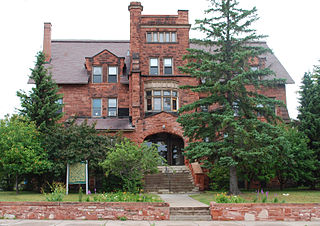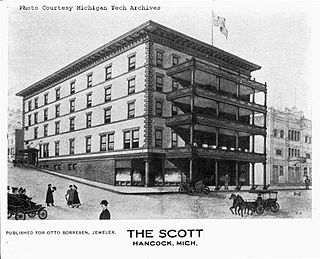
Houghton is the largest city and county seat of Houghton County in the U.S. state of Michigan. Located on the Keweenaw Peninsula, Houghton is the largest city in the Copper Country region. It is the fifth largest city in the Upper Peninsula, with a population of 7,708 at the 2010 census. Houghton is the principal city of the Houghton micropolitan area, which includes all of Houghton and Keweenaw County.

Hancock is a city in Houghton County in the U.S. state of Michigan. It is located across the Keweenaw Waterway from the city of Houghton on the Keweenaw Peninsula. The population was 4,634 at the 2010 census. The city has been consistently ranked as the third-snowiest city in the United States by The Weather Channel.

Houghton County is a county in the Upper Peninsula in the U.S. state of Michigan. As of the 2010 census, the population was 36,628. The county seat and largest city is Houghton. Both the county and the city were named for Michigan State geologist and Detroit Mayor Douglass Houghton.

The Quincy Mine is an extensive set of copper mines located near Hancock, Michigan. The mine was owned by the Quincy Mining Company and operated between 1846 and 1945, although some activities continued through the 1970s. The Quincy Mine was known as "Old Reliable," as the Quincy Mine Company paid a dividend to investors every year from 1868 through 1920. The Quincy Mining Company Historic District is a United States National Historic Landmark District; other Quincy Mine properties nearby, including the Quincy Mining Company Stamp Mills, the Quincy Dredge Number Two, and the Quincy Smelter are also historically significant.

Keweenaw National Historical Park is a unit of the U.S. National Park Service. Established in 1992, the park celebrates the life and history of the Keweenaw Peninsula in the Upper Peninsula of the U.S. state of Michigan. As of 2009, it is a partly privatized park made up of two primary units, the Calumet Unit and the Quincy Unit, and 21 cooperating "Heritage Sites" located on federal, state, and privately owned land in and around the Keweenaw Peninsula. The National Park Service owns approximately 1,700 acres (690 ha) in the Calumet and Quincy Units. Units are located in Baraga, Houghton, Keweenaw, and Ontonagon counties.

This is a list of the National Register of Historic Places listings in Houghton County, Michigan.

The A.E. Seaman Mineral Museum, currently located on the campus of Michigan Technological University in Houghton, Michigan, is the official mineral museum of the state of Michigan and is a heritage site of the Keweenaw National Historical Park. The museum is named for professor Arthur Edmund Seaman, who worked at Michigan Tech in the late 19th and early 20th centuries, and was the museum's curator from 1928 until 1937.

The Calumet Downtown Historic District is a historic district located in Calumet, Michigan, on 5th Street and 6th Street, between Scott Street and Pine Street. It is also known as the Red Jacket Downtown Historic District, reflecting the original name of the village. The Historic District is completely contained in the Calumet Historic District and the Keweenaw National Historical Park. It was designated a Michigan State Historic Site in 1973 and listed on the National Register of Historic Places in 1974.

The J. Vivian Jr. and Company Building is a commercial building located at 342 Hecla Street in Laurium, Michigan. in the Italian Renaissance Revival, and Italianate architectural styles, it was listed on the National Register of Historic Places in 2003.

The Quincy Street Historic District is a historic district located along the 100, 200, and 300 blocks of Quincy Street, along with 416 Tezcuco Street, in Hancock, Michigan. The Hancock Town Hall and Fire Hall is located in the district. The district was listed on the National Register of Historic Places in 1988.

The Hancock Town Hall and Fire Hall is a public building located at 399 Quincy Street in the Quincy Street Historic District in Hancock, Michigan. It is also known as the Hancock City Hall. It was designated a Michigan State Historic Site in 1977 and was listed on the National Register of Historic Places in 1981.

Old Main, Suomi College is an educational building located on Quincy Street on the Finlandia University campus in Hancock, Michigan. It is also known as the Suomi College Building. It was designated a Michigan State Historic Site in 1959 and listed on the National Register of Historic Places in 1972.

The Quincy Smelter, also known as the Quincy Smelting Works, is a former copper smelter located on the north side of the Keweenaw Waterway in Ripley, Michigan. It is a contributing property of the Quincy Mining Company Historic District, a National Historic Landmark District. The smelter was built in 1898 by the Quincy Mining Company, operating from 1898 to 1931 and again from 1948 to 1971. The smelter was part of a Superfund site from 1986 to 2013.

The Houghton County Courthouse is a government building located at 401 E. Houghton Street in Houghton, Michigan. It was designated a Michigan State Historic Site in 1974 and placed on the National Register of Historic Places in 1975.

Jacobsville Sandstone is a red sandstone formation, marked with light-colored streaks and spots, primarily found in northern Upper Michigan, portions of Ontario, and under much of Lake Superior. Desired for its durability and aesthetics, the sandstone was used as an architectural building stone both locally and around the United States. The stone was extracted by thirty-two quarries throughout the Upper Peninsula approximately between 1870 and 1915.

The Kaleva Temple is a commercial building located on Trimountain Avenue in South Range, Michigan. It was listed on the National Register of Historic Places in 1982.

The Carnegie Museum of the Keweenaw in Houghton, Michigan, is a non-collecting museum that houses changing exhibits about local cultural and natural history. The building is so named as it was built with a 1908 grant from Andrew Carnegie. It served as the public library for Houghton, Michigan from its opening in 1910 until 2006. It is the former building of the Portage Lake District Library. The building was built in 1909, at the site originally occupied by the Armory Building for Company G of the Houghton Light Infantry, using a $15,000 grant from Andrew Carnegie. The museum opened in fall 2006 after the library moved to its new location.

Trinity Episcopal Church is a Gothic Revival-style Episcopal church at 205 East Montezuma Avenue in Houghton, Michigan. It was designated a Michigan State Historic Site on July 17, 1986. It is the second of two church buildings to exist on the site; the current one replaced a wooden structure in 1910. The church's philosophy is built on the Oxford Movement.

The Kerredge Theatre was a theatre located in the 1st block of East Quincy Street in Hancock, Michigan, next to the Scott Hotel. It was built by William and Ray Kerredge and completed by Fall 1902. The theatre hosted many vaudeville groups and could accommodate 1250 patrons. The theatre was fronted by a circular balcony. The Kerredge Theatre was built in response to the construction two years earlier of The Calumet Theatre in Calumet, Michigan.
The Breitung Hotel, named for Edward Breitung, was a hotel at 111 South Pioneer Avenue in Negaunee, Michigan. The hotel, designed by David M. Harteau, was built from 1879 to 1880. The building was listed as a Michigan State Historic Site on June 20, 1985.




















